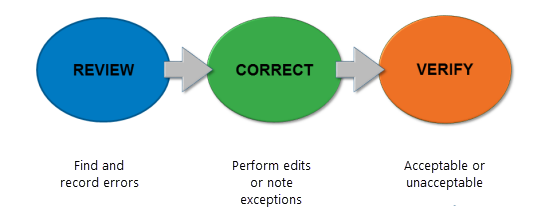Available with Data Reviewer license.
To produce high-quality information products and perform accurate spatial analysis, your source data must be high quality and well maintained. Data Reviewer allows you to manage data for data production and analysis by providing a system for automating and simplifying data quality control that can improve data integrity.
Data Reviewer provides a set of quality control (QC) tools that allow an efficient and consistent data review process. This includes tools that support both automated and semiautomated data analysis to detect errors in a feature's integrity, attribution, or spatial relationships with other features. Detected errors are stored so you can review them to correct workflows and perform data quality reporting.
Automated data review
Automated data review evaluates a feature's quality without human intervention. Data Reviewer includes a library of configurable checks that allow you to validate data based on your quality requirements. Checks are configured through geodatabase rules (attribute-based workflows) or Reviewer batch jobs to assess different aspects of a feature's quality and its fitness for use.
To learn more about Data Reviewer automated workflows for assessing data quality, see the following topics:
Semiautomated data review
Not all errors in your data can be detected using automated methods. Semiautomated review assesses data quality using methods that typically involve guided workflows requiring human interaction and input. Visual review is the most common form of semiautomated review and is used to assess quality in ways that automated data review cannot. This includes identifying missing, misplaced, or miscoded features and other issues that automated checks may not detect.
To learn more about using Data Reviewer to implement semiautomated workflows to assess data quality, see the following topics:
Error management
Data Reviewer allows management of error results from detection through correction and verification. These capabilities improve data quality by identifying the source, location, and cause of the errors. Costs are reduced and duplicated work is avoided by providing insight into how the error was detected, who corrected it, and whether the correction has been verified as acceptable.
Errors detected during the data review process are tracked through a defined life cycle process. This process includes three life cycle phases: Review, Correction, and Verification.

Each phase contains one or more status values that describe the actions taken as the error progresses from one phase to another.
Geodatabase rules can be created to evaluate errors during editing sessions (constraint rules) or to evaluate existing data (validation rules). Validation rules errors are displayed in the Error Inspector pane.
Reviewer batch jobs are created using tools in ArcMap. Errors returned by batch jobs are stored in a Reviewer session.
To learn more about Data Reviewer error management workflows, see the following topics: